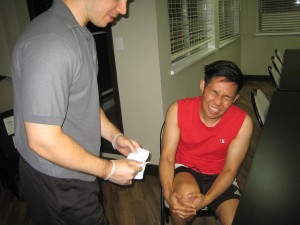Fact Checked
Overview – What Is A Sprain?
- A sprain is the stretch or split of tendon which connects the bones.
- Can take place in both the upper and lower section of the body.
- Most frequent places people sprain – wrists, knee and ankles.
What Are The Causes Of A Sprain
- Accidents and traumas.
- Picking up heavy items.
- Injuries from sports.
Symptoms Of A Sprain
- Pain.
- Inflammation.
- Bumps other than inflammation.
- Bruising or redness surrounding the strained joint.
- Lack of sensation.
- Not able to move the joint.
Treatment For A Sprain

- Apply something cold such as an ice pack to the injured region for 20 minutes.
- This can be done several times a day to reduce swelling.
- Wrapping ice in a towel works perfectly.
- Keep the wounded leg elevated on a cushion.
- Take anti-inflammatory medication if required.
Prevention For A Sprain
- Avoid working out or doing sport when you are exhausted.
- Consume a well-balanced meal for strong bones and muscles.
- Exercise every day, especially stretching exercises.
- Do some warm-up routines before exercising.
- When exercising, try to exercise in an open space away from clutter.
- Jog on an even surface.
- Do not wear shoes that don’t fit you or shoes that are awkward to walk with.
More Steps On Treating A Sprained Joint:
- Stay protected. If you are not the casualty, practice worldwide safety measures and wear protective gear if you have access to some.
- Do not phone for an ambulance for a sprain. It is suggested to visit a doctor for a sprained joint if:
- The pain is severe;
- The casualty is unable to put any pressure on it;
- It appears different than unhurt joint;
- Casualty can’t move it;
- Casualty can’t stand on their sprain for more than a few seconds;
- There is a lack of sensation with regards to your sprained joint;
- Redness starts to show on the sprained joint;
- If you have sprained it numerous times before; and
- There is pain, inflammation, or redness over a part of your foot.
- Make use of the RICE approach to treat the sprain.
- Rest the sprained joint by not putting a direct pressure on it. Use a stick or some type of support on the uninjured side to slant away from the sprained foot or ankle.
- Ice the sprain by putting an ice pack over the injury to reduce swelling.
- Compress the sprain with a stretchy bandage. Ask an expert to demonstrate how to correctly apply an elastic bandage around a sprained joint.
- Elevate the sprain and move it above the level of the heart especially within the first 48 hours.
Related Video On Sprains
https://www.youtube.com/watch?v=UWqVASo1blA
